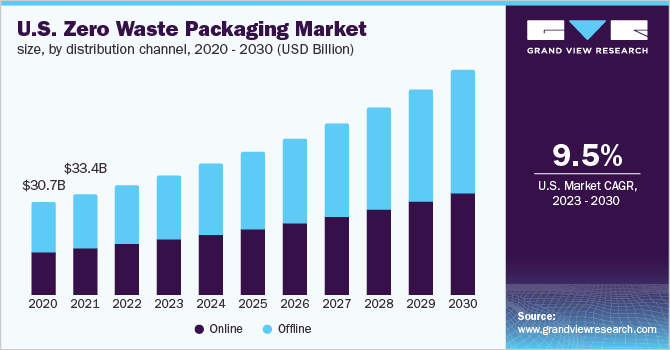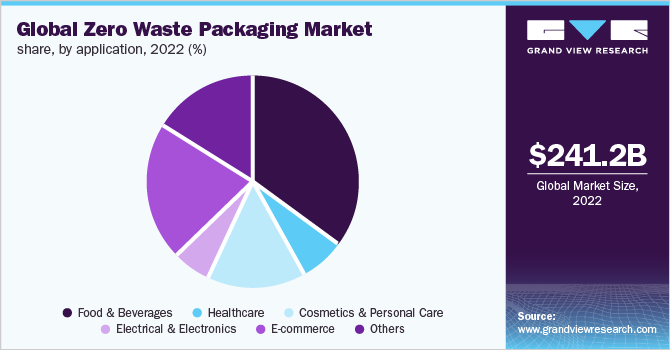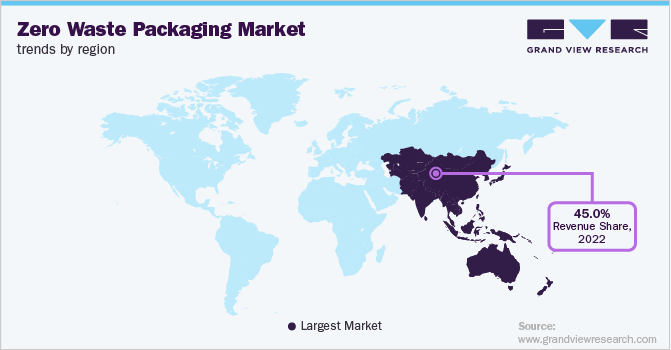- Home
- »
- Plastics, Polymers & Resins
- »
-
Global Zero Waste Packaging Market Share Report, 2030GVR Report cover
![Zero Waste Packaging Market Size, Share & Trends Report]()
Zero Waste Packaging Market Size, Share & Trends Analysis Report By Material (Paper & Cardboard, Biopolymer), By Type, By Distribution Channel, By Application, By Region, And Segment Forecasts, 2023 - 2030
- Report ID: GVR-4-68040-015-5
- Number of Report Pages: 115
- Format: PDF, Horizon Databook
- Historical Range: 2018 - 2021
- Forecast Period: 2023 - 2030
- Industry: Bulk Chemicals
Report Overview
The global zero waste packaging market size was valued at USD 241.2 billion in 2022 and is expected to expand at a compound annual growth rate (CAGR) of 9.6% from 2023 to 2030. The market growth can be attributed to the continuously rising focus on sustainable packaging solutions and awareness about the circular economy, which can increase the efficiency of the manufacturers as well as support environment-friendly developments by decreasing carbon footprints across the globe.

The rising environmental concerns owing to the increasing amount of packaging waste across the globe, especially across developing economies, are driving the demand for zero waste packaging. Zero waste packaging refers to packaging solutions, where the discarded packaging product either can be utilized for further processes such as recycling/reuse or is decomposed in the natural environment by microorganisms. In other words, packaging waste should not land up in landfill or pollute the environment in any possible way. Such packaging solutions are considered under zero waste packaging.
The U.S. economy is highly developed and is continuously involved in developing proper infrastructure for the recycling and collection of discarded packaging materials. Thus, the country is supporting the growth of the market. Moreover, the presence of global entities, such as the World Wide Fund For Nature (WWF) and Zero Waste International Alliance (ZWIA) for spreading awareness about environment-friendly packaging solutions and controlling the production activities of packaging manufacturers, is supporting the growth.
The rising awareness among consumers about the proper segregation and disposal of packaging waste is contributing to the growth. Additionally, the increasing efforts of governments and respective municipalities for the proper segregation of waste and effective waste management of packaging products are expected to support the growth. There is an increasing awareness about environment-friendly packaging among end-users through the means of electronic media or social media, where concerned authorities are spreading awareness regarding the pros and cons of packaging waste.
COVID-19 Impact
The market has witnessed slower growth owing to the halt in the movement of international shipments, which has negatively influenced the movement reach of discarded waste to the destination for recycling or reuse. Additionally, respective government efforts to slow down the spread of coronavirus through any physical contact by imposing lockdowns and restrictions on public gatherings have further resulted in an increase in packaging waste.
However, the post-pandemic period has resulted in significant market growth owing to the increasing concerns over degrading environmental conditions. Nationwide lockdowns have resulted in improved environmental conditions during this period and electronic media has circulated awareness about the improving water bodies and air conditions in respective geographical regions. This has further increased environmental awareness among end-users. Therefore, the demand for packaging with lower carbon footprints is increasing post-pandemic across the globe.
Material Insights
The paper and cardboard segment held the largest revenue share of over 75.0% in 2022 and it is projected to maintain its dominance throughout the forecast period. The developed infrastructure for the recycling of cardboard packaging for further use of recycled material in the packaging industry for application products is supporting segment growth. According to the U.S. Environmental Protection Agency, paper and paperboard containers and packaging have around 80% of recycling.
The biopolymer segment including polylactic acid (PLA), polybutylene adipate terephthalate (PBAT), and starch blends combined is projected to exhibit the fastest growth rate over the forecast period. The material is gaining growth in the packaging segment because it can provide potential substitutes for plastic that are environmentally friendly and are increasingly preferred in the end-use market.
Furthermore, the rising concerns associated with plastic packaging waste, including soil pollution and water pollution, especially in rivers and oceans, are generating demand for alternative products and solutions to this existing problem. Ocean life, including plants, animals, and dependent organisms on salt water, is majorly suffering from the disposal of plastic packaging and some of these may become extinct from the planet in the near future. According to National Geographic, over one million marine animals die because of the tons of plastic disposed of into the oceans every year.
According to the ocean literacy portal of UNESCO, currently, there are about 50-75 trillion pieces of plastic and microplastics in the ocean. 80 percent of marine pollution is caused by plastic waste and around 8 to 10 million metric tons of plastic end up in the ocean each year. According to the Center for Biological Diversity, fish in the North Pacific ingest 12,000 to 24,000 tons of plastic each year. This causes intestinal injury and death and transfers plastic up the food chain to bigger fish, marine mammals, and human seafood eaters. As a result, the demand for zero waste packaging is projected to witness growth over the forecast period.
Type Insights
Reusable/recyclable packaging captured the largest revenue share of over 95.0% in 2022. The segment is also projected to maintain its dominance throughout the forecast period. Reusable/recyclable packaging is typically composed of materials including paper and cardboard, glass, and metal, which are generally preferred. The developing infrastructure for proper waste management and the use of packaging material in the circular economy concept is projected to support the growth of the segment over the forecast period.
The increasing demand for compostable packaging, which is manufactured from biopolymer, is anticipated to support the growth of the segment over the forecast period. The increasing penetration of home compostable bins, which can convert biodegradable waste into nutrient-rich soil in a certain period to be used for gardening purposes, is a key growth factor. Thus, compostable packaging can be managed at home through these systematic arrangements and can have a lesser impact on the environment and dependent bodies. For instance, Ecovative LLC provides Mushroom Packaging made with hemp hurd and mycelium. It is an eco-friendly alternative to styrofoam, and can easily be converted into compost by breaking it into smaller pieces and distributing them into compost bins or straight into gardening soil.
Distribution Channel Insights
The offline segment accounted for the largest revenue share of over 50.0% in 2022 and is projected to maintain its dominance throughout the forecast period. The high penetration of the offline system in the end-use market is the major factor supporting its dominance in the global market.
The online segment is projected to exhibit the fastest CAGR of 9.9% over the forecast period. This can be credited to the increasing penetration of online sales in the global market, especially after the coronavirus pandemic, which has boosted awareness regarding online sales platforms. The pandemic has created the need for online transaction platforms in order to avoid physical gatherings, which is also a major factor supporting the growth.
Moreover, the increasing internet penetration in developing economies at affordable prices is supporting the growth of the segment. The increasing penetration of social media vendors in the global market along with their wider portfolio to select from is another factor supporting industry growth.
Application Insights
The food and beverages segment held the largest revenue share of over 30.0% in 2022, as the wholesale food market is having a significant penetration of corrugated packaging, which is contributing to the growth. Additionally, the beverages market is having significant use of glass and metal packaging, which are in the close system of reuse or recycling; therefore, the segment is leading the market.

The e-commerce segment is projected to exhibit the fastest growth rate over the forecast period. The convenience of shopping at home and various coupons and offers provided by e-shopping platforms to their customers are major factors boosting the segment growth. Additionally, the affordability and easy penetration of internet connectivity and mobile phones, especially in developing economies, are further supporting segment growth over the forecast period. According to the Telecom Regulatory Authority of India's (TRAI's), “Yearly Performance Indicators - Indian Telecom Sector” for 2021, India has 829.3 million internet users and a total of 1,178.4 million telecom subscribers, as of December 31, 2021.
Regional Insights
Asia Pacific accounted for the maximum revenue share of over 45.0% in 2022 and the region is projected to maintain its dominance throughout the forecast timeframe. China is majorly contributing to the high growth of the regional market. The presence of numerous small and medium players in the country, which are involved in the manufacturing of paper and cardboard packaging and recycling of discarded packaging materials, is supporting the industry's growth.

Europe accounted for the second-largest share in 2022 and the region is projected to maintain its position throughout the forecast timeframe. The high awareness about environmental protection and respective measures for combating the environment’s degrading condition is further supporting regional growth.
Additionally, the presence of organizations such as the European Union, TUV AUSTRIA, and Swiss Federal Laboratories for Materials Science (Empa) is supporting the demand for zero waste packaging in the regional market. The presence of manufacturers such as DS Smith plc, Biome Bioplastics Limited, BIOPLA, and Sulapac Oy is contributing to the growth of the market.
Key Companies & Market Share Insights
The market is highly fragmented with the presence of various small and medium-sized players. Companies are also making efforts to expand their production capacities and geographical footprints. Industry players are also focusing on more sustainable packaging solutions owing to an increase in the number of rules and regulations against increasing plastic waste. Additionally, zero waste packaging manufacturers are expanding their product reach to the end-users via online marketing channels due to their ability to reach the target audience who is aware of sustainable lifestyles and adopting such practices in their daily routine.
Furthermore, the continuously rising efforts by respective governments of countries for environmental protection are likely to exhibit significant changes in the manufacturing practices of players in the market over the forecast period. For instance, in August 2022, the Indian government approved a startup loan of USD 181,892 (Rs. 15 Million) for manufacturing and commercializing “compostable” plastic. This initiation is intended to mitigate the usage of single-use plastic. Some prominent players in the global zero waste packaging market include:
-
Ecovative LLC
-
DS Smith plc
-
Avani Eco
-
Biome Bioplastics Limited
-
BIOPLA
-
Loliware Inc.
-
Evoware
-
Sulapac Oy
-
TIPA
-
World Centric
-
Notpla Limited
-
Regeno
-
Hero Packaging
Zero Waste Packaging Market Report Scope
Report Attribute
Details
Market size value in 2023
USD 263.4 billion
Revenue forecast in 2030
USD 502.6 billion
Growth Rate
CAGR of 9.6% from 2023 to 2030
Base year for estimation
2022
Historical data
2018 - 2021
Forecast period
2023 - 2030
Quantitative units
Revenue in USD million/billion and CAGR in % from 2023 to 2030
Report coverage
Revenue forecast, company ranking, competitive landscape, growth factors, and trends
Segments covered
Material, type, distribution channel, application, region
Regional scope
North America; Europe; Asia Pacific; Central & South America; Middle East & Africa
Country scope
U.S.; Canada; Mexico; Germany; U.K.; France; Italy; Spain; China; Japan; India; South Korea; Brazil; Saudi Arabia
Key companies profiled
Ecovative LLC; DS Smith plc; Avani Eco; Biome Bioplastics Limited; BIOPLA; Loliware Inc.; Evoware; Sulapac Oy; TIPA; World Centric; Notpla Limited; Regeno; Hero Packaging
Customization scope
Free report customization (equivalent up to 8 analysts working days) with purchase. Addition or alteration to country, regional & segment scope.
Pricing and purchase options
Avail customized purchase options to meet your exact research needs. Explore purchase options
Global Zero Waste Packaging Market Segmentation
This report forecasts revenue growth at the global, regional, and country levels and provides an analysis of the latest industry trends and opportunities in each of the sub-segments from 2018 to 2030. For the purpose of this study, Grand View Research has segmented the global zero waste packaging market report on the basis of material, type, distribution channel, application, and region:
-
Material Outlook (Revenue, USD Million, 2018 - 2030)
-
Biopolymer
-
Paper and Cardboard
-
Glass Packaging
-
Metal Packaging
-
-
Type Outlook (Revenue, USD Million, 2018 - 2030)
-
Reusable/Recyclable Packaging
-
Compostable Packaging
-
Edible Packaging
-
-
Distribution Channel Outlook (Revenue, USD Million, 2018 - 2030)
-
Online
-
Offline
-
-
Application Outlook (Revenue, USD Million, 2018 - 2030)
-
Food & Beverages
-
Healthcare
-
Cosmetics & Personal Care
-
Electrical & Electronics
-
Others
-
E-commerce
-
-
Regional Outlook (Revenue, USD Million, 2018 - 2030)
-
North America
-
U.S.
-
Canada
-
Mexico
-
-
Europe
-
Germany
-
U.K.
-
France
-
Italy
-
Spain
-
-
Asia Pacific
-
China
-
Japan
-
India
-
South Korea
-
-
Central & South America
-
Brazil
-
-
Middle East & Africa
-
Saudi Arabia
-
-
Frequently Asked Questions About This Report
b. The global zero waste packaging market size was estimated at USD 241.2 billion in 2022 and is expected to reach USD 263.4 billion in 2023.
b. The global zero waste packaging market is expected to grow at a compound annual growth rate of 9.6% from 2023 to 2030 to reach USD 502.6 billion by 2030.
b. Paper & cardboard segment by material dominated the market with a revenue share of nearly 77.2% in 2021 owing to its high recycling rate in the global market.
b. Some of the key players operating in the zero waste packaging market include Ecovative LLC, DS Smith plc, Avani Eco, Biome Bioplastics Limited, BIOPLA, Loliware Inc., Evoware, Sulapac Oy, TIPA, and Henkel Corporation.
b. The key factors that are driving the zero waste packaging market include an increasing number of sustainable packaging startups, increased demand for environment friendly packaging solutions, and growing e-commerce giants worldwide.
Share this report with your colleague or friend.
![gvr icn]()
NEED A CUSTOM REPORT?
We can customize every report - free of charge - including purchasing stand-alone sections or country-level reports, as well as offer affordable discounts for start-ups & universities. Contact us now
![Certified Icon]()
We are GDPR and CCPA compliant! Your transaction & personal information is safe and secure. For more details, please read our privacy policy.
We are committed towards customer satisfaction, and quality service.
"The quality of research they have done for us has been excellent."





